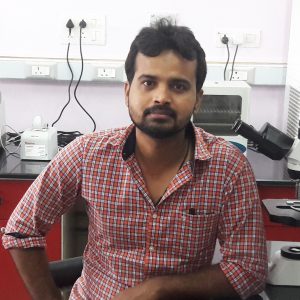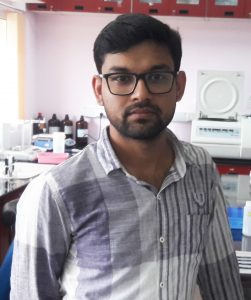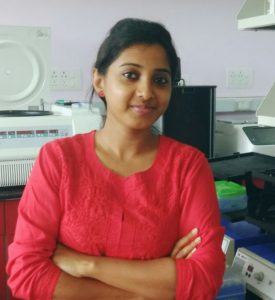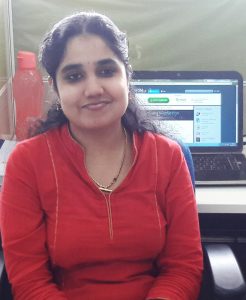Academics
| Degree | University/Institution |
|---|---|
| MSc. in Medical Biochemistry | JIPMER, Pondicherry University. |
| Ph.D. | Dept. of Biochemistry, Indian Institute of Science, Bangalore. |
Work Experience
| Position | University/Organisation | Period |
|---|---|---|
| Scientist-E | Institute of Life Sciences, Bhubaneswar, India. | Jan 2020 onwards |
| Scientist-D | Institute of Life Sciences, Bhubaneswar, India. | Nov 2015 - Dec 2019 |
| Ramanujan Fellow | Centre for Infectious Disease Research & Department of Biochemistry, IISc, Bangalore, India. | Nov 2010 - Oct 2015 |
| Postdoctoral Research Fellow | School of Biological Sciences, Nanyang Technological University, Singapore. | Jan 2010 - Sep 2010 |
| Research Associate | School of Biological Sciences, Nanyang Technological University, Singapore. | Sep 2009 - Dec 2009 |
Awards & Recognition
| Details |
|---|
Awards Received National Academy of Vector Borne Diseases (NAVBD) Award for Outstanding Contribution on Molecular Biology from National Academy of Vector Borne Diseases, February 2017. Global Health Travel Award funded by the Bill and Melinda Gates Foundation to attend Keystone Symposia on “The Science of Malaria Eradication” held at Mexico in February, 2014. Awarded Ramanujan Fellowship for the year 2010 by Department of Science & Technology, Govt. of India. Prof. Giri Memorial Medal, Institute of science, Bangalore for the Best Ph.D. Thesis of the year 2009-2010, Dept. of Biochemistry, Indian Institute of science, Bangalore. Dr. A. S. Perumal Award, Indian Institute of science, Bangalore for the Best Performance in Research Training Program, Dept. of Biochemistry, Indian Institute of science, Bangalore. Sathya Bhama Award, JIPMER, Pondicherry University for the Best Outgoing Student (2003). Best Outgoing Student Award (2000), Sri Sankara Arts and Science College, Madras University Other Recognitions Reviewer for BIRAC’s Biotechnology Ignition Grant (BIG) scheme Invited Reviewer for Nature Communications, Scientific Reports, Journal of Bacteriology & Parasitology, Molecular Biotechnology, Experimental Parasitology, and Infection and Immunity Member of Doctoral Advisory Committee, Manipal University (2013-2015) |
Research
| Details |
|---|
Parasitism relies on the successful exploitation of host cell resources through a wide range of crosstalk accomplished between host and parasite metabolic networks. Given the complexity of Plasmodium life cycle that alternates between vertebrate (human) and invertebrate (mosquito) hosts, the ease with which the malaria parasite contends different host environments remain astounding. While many studies have revealed these aspects in the asexual stages residing in human RBCs, the host-parasite interactions in the sexual and liver stages are yet to be explored in detail. Interestingly, the host niches of sexual and liver stages differ significantly from metabolically inert RBCs circulating in nutrient-rich plasma. Also, the molecular events underlying the parasite development and differentiation in the mosquito and liver stages are poorly understood.
|
Publications
| Details |
|---|
Publications 1) Ghosh, S., Kundu, R., Chandana, M., Das, R., Anand, A., Beura, S., Bobde, R.C., Jain, V., Prabhu, S.R., Behera, P.K., Mohanty, A.K., Chakrapani, M., Satyamoorthy, K., Suryawanshi, A.R., Dixit, A., Padmanaban, G. & Nagaraj, V.A. (2023). Distinct evolution of type I glutamine synthetase in Plasmodium and its species-specific requirement. Nature Communications, 14, 4216. Book Chapters 1) Padmanaban, G. and Nagaraj, V.A. (2017). Curcumin from turmeric as an adjunct drug? In: Studies in Natural Products Chemistry, Bioactive Natural Products. Edited by Atta-ur-Rahman. Volume 57, 2018, Pages 179-202. 2) Nagaraj, V.A., Rangarajan, P.N. and Padmanaban, G. (2014). Porphyrin Metabolism. Encyclopedia of Malaria. Springer, Edited by Hommel, M. and Kremsner. P.G. 1-11. 3) Padmanaban, G., Nagaraj, V.A. and Rangarajan, P.N. (2013). Unique Features of heme biosynthesis in the malaria parasite. Handbook of Porphyrin Science. With Applications to Chemistry, Physics, Materials Science, Engineering, Biology and Medicine. World Scientific Publishers, Edited by Kadish, K.M., Smith, K.M., Guilard, R. and Ferreira, G.C. 27, 168-205. List of patents granted/filed: 1) A pharmaceutical composition to combat artemisinin resistance in malaria. Indian Patent Application No. 202231018911. |
Group
| Details | ||||||||||
|---|---|---|---|---|---|---|---|---|---|---|
|
Grants
| Details |
|---|
Research Grants 1) Evaluation of safety and efficacy of curcumin (Biocurcumax capsule) as an adjunct drug to standard therapy [(Artesunate) + (Sulfadoxine-Pyrimethamine) tablet] for treatment of uncomplicated P. falciparum malaria. Phase-IIa Double-blind Clinical Trial. DBT. 2020-2024. (Principal Investigator for ILS; In collaboration with NIMR, New Delhi, Ipca Laboratories Ltd., Mumbai, Arjuna Naturals Pvt Ltd., Aluva, Ispat General Hospital, Rourkela and Shaheed Hospital, Dalli Rajhara) 2) Screening of Plant Extracts from North East for Identifying Phytochemicals with Potent Antimalarial Activity against Asexual, Sexual and Liver stages of Malaria Parasite. DBT. 2020-2023.(Principal Investigator for ILS; In collaboration with IBSD, Imphal) 3) Amino acid requirements in the sexual and liver stages of malaria parasite – An immutable and versatile target for malaria transmission. DST-SERB. 2017-2020 (Principal Investigator) 4) Malaria Parasite Biology – An Avenue to Discover New Drug Targets. DBT. 2016-2020. ( In collaboration with Indian Institute of Science, Bangalore & Jawaharlal Nehru Centre for Advanced Scientific Research, Bangalore) 5) An Innovative Algorithm-Based Detection of Identical Multi-Repeat Sequences (IMRS) in the Genome of Plasmodium and its Validation in Malaria Diagnostics. BIRAC. 2014-2016. (In collaboration with Jigsaw Biosolutions, Bangalore) 6) Exploring the New Facets of Plasmodium Biology to Identify Potential Drug Targets. DST Ramanujan Fellowship. 2010-2015. 7) Generation of Prototype Lateral Flow Assay Kit using Antigen Specific Hybridomas to Develop Rapid Diagnostic Test for Clinical Diagnosis of Malaria. DBT-SBIRI. 2012-2015. (In collaboration with Indian Immunologicals, Hyderabad) 8) Deciphering the Functional Significance of Rab-mediated Vesicular Trafficking Processes in Malaria Parasite. DST-FAST TRACK. 2012-2015. Also, there is Intramural Support from ILS. |
Contacts
| Address | Fax | Office | |
|---|---|---|---|
| arun@ils.res.in | Lab No: 9, Infectious Disease Biology, Institute of Life Sciences, Nalco Square, Bhubaneswar-751023, India. | 0091 674 2300728 | Lab: +91 674 2304292; Office: +91 674 2304317 |
Highlights
| Details |
|---|
Media coverages: 1) Therapeutic interventions to prevent malaria mortality found in Odisha. February 22, 2023. The New Indian Express. https://www.newindianexpress.com/states/odisha/2023/feb/22/therapeutic-interventions-to-prevent-malaria-mortality-found-in-odisha-2549804.html |
Positions
| Details |
|---|
At present, our laboratory is looking for enthusiastic Post-doctoral fellows and Junior Research Fellows who are willing to work on the fascinating biology of malaria parasite and make a significant contribution towards understanding the developmental aspects of Plasmodium transmission stages, transmission biology, disease virulence etc. For Post-doctoral positions, those who are having fellowships may email their resume to arun@ils.res.in. Candidates willing to apply for post-doctoral fellowships of various funding agencies may also email their research interest on Plasmodium biology. Preference will be given to those who are having molecular parasitology/immunology/vector biology background. For JRF positions, candidates can look at ILS website for advertisements related to current openings. |


 Our laboratory is interested in understanding the molecular events that are involved in the sexual and liver stage development of Plasmodium using P. falciparum (human malaria parasite) as an in vitro model and P. berghei (rodent malaria parasite) as an in vivo model to study the entire life cycle of malaria parasite. We combine genetic, biochemical and molecular biological approaches to decipher the significance of metabolic pathways and metabolic adaptability of Plasmodium in the sexual and liver stages thereby, identifying the limiting metabolites and nutrients that become essential for the survival of parasite.
Our laboratory is interested in understanding the molecular events that are involved in the sexual and liver stage development of Plasmodium using P. falciparum (human malaria parasite) as an in vitro model and P. berghei (rodent malaria parasite) as an in vivo model to study the entire life cycle of malaria parasite. We combine genetic, biochemical and molecular biological approaches to decipher the significance of metabolic pathways and metabolic adaptability of Plasmodium in the sexual and liver stages thereby, identifying the limiting metabolites and nutrients that become essential for the survival of parasite.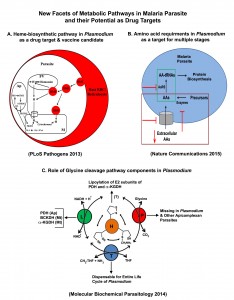 Our studies on heme and amino acid pathways of malaria parasite have revealed the existence of unique requirements in the sexual and liver stages that are critical for parasite development and therefore, disease transmission. Further, PbALAS (first enzyme in heme-biosynthetic pathway) knockout sporozoites could be explored as a potential genetically-attenuated vaccine candidate for liver stages in mouse model. Also, we are trying to understand the physiological relevance of transporters in the malaria parasite. To summarize, understanding host-parasite interactions at the level of nutritional requirements together with the transport mechanisms that are involved in the host-parasite interplay would help to identify the essential components required for parasite survival and give insights into basic parasite biology. The depletion of these essential components and prevention of their uptake would provide novel intervention strategies and new targets to interfere with disease progression and transmission. Of late, we have also started examining the molecular re-programming events occurring in Plasmodium that are responsible for disease virulence.
Our studies on heme and amino acid pathways of malaria parasite have revealed the existence of unique requirements in the sexual and liver stages that are critical for parasite development and therefore, disease transmission. Further, PbALAS (first enzyme in heme-biosynthetic pathway) knockout sporozoites could be explored as a potential genetically-attenuated vaccine candidate for liver stages in mouse model. Also, we are trying to understand the physiological relevance of transporters in the malaria parasite. To summarize, understanding host-parasite interactions at the level of nutritional requirements together with the transport mechanisms that are involved in the host-parasite interplay would help to identify the essential components required for parasite survival and give insights into basic parasite biology. The depletion of these essential components and prevention of their uptake would provide novel intervention strategies and new targets to interfere with disease progression and transmission. Of late, we have also started examining the molecular re-programming events occurring in Plasmodium that are responsible for disease virulence.